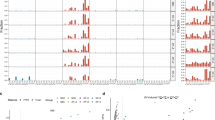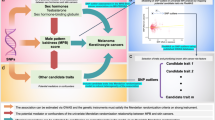Abstract
Xeroderma pigmentosum (XP) patients with a defect in the nucleotide excision repair gene XPA, develop tumors with a high frequency on sun-exposed areas of the skin. Here we describe that hairless XPA-deficient mice also develop skin tumors with a short latency time and a 100% prevalence after daily exposure to low doses of U.V.B. Surprisingly and in contrast to U.V.B.-exposed repair proficient hairless mice who mainly develop squamous cell carcinomas, the XPA-deficient mice developed papillomas with a high frequency (31%) at a U.V. dose of 32 J/m2 daily. At the highest daily dose of 80 J/m2 mainly squamous cell carcinomas (56%) and only 10% of papillomas were found in XPA-deficient hairless mice. p53 gene mutations were examined in exons 5, 7 and 8 and were detected in only 3 out of 37 of these skin tumors, whereas in tumors of control U.V.B.-irradiated wild type littermates this frequency was higher (45%) and more in line with our previous data. Strikingly, a high incidence of activating ras gene mutations were observed in U.V.B.-induced papillomas (in 11 out of 14 tumors analysed). In only two out of 14 squamous cell carcinomas we found similar ras gene mutations. The observed shift from squamous cell carcinomas in wild type hairless mice to papillomas in XPA-deficient hairless mice, and a corresponding shift in mutated cancer genes in these tumors, provide new clues on the pathogenesis of chemically- versus U.V.B.-induced skin carcinogenesis.
This is a preview of subscription content, access via your institution
Access options
Subscribe to this journal
Receive 50 print issues and online access
$259.00 per year
only $5.18 per issue
Buy this article
- Purchase on Springer Link
- Instant access to full article PDF
Prices may be subject to local taxes which are calculated during checkout
Similar content being viewed by others
Author information
Authors and Affiliations
Rights and permissions
About this article
Cite this article
de Vries, A., Berg, R., Wijnhoven, S. et al. XPA-deficiency in hairless mice causes a shift in skin tumor types and mutational target genes after exposure to low doses of U.V.B.. Oncogene 16, 2205–2212 (1998). https://doi.org/10.1038/sj.onc.1201744
Received:
Revised:
Accepted:
Published:
Issue Date:
DOI: https://doi.org/10.1038/sj.onc.1201744
Keywords
This article is cited by
-
Enhanced Global Genome Nucleotide Excision Repair Reduces UV Carcinogenesis and Nullifies Strand Bias in p53 Mutations in Csb−/- Mice
Journal of Investigative Dermatology (2010)
-
Transcription-coupled nucleotide excision repair in mammalian cells: molecular mechanisms and biological effects
Cell Research (2008)
-
Mice with skin-specific DNA repair gene (Ercc1) inactivation are hypersensitive to ultraviolet irradiation-induced skin cancer and show more rapid actinic progression
Oncogene (2006)
-
Persistence of p53 mutations and resistance of keratinocytes to apoptosis are associated with the increased susceptibility of mice lacking the XPC gene to UV carcinogenesis
Oncogene (1999)
-
Age-associated decreases in human DNA repair capacity: Implications for the skin
AGE (1999)



